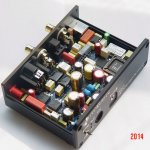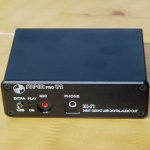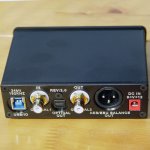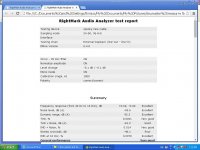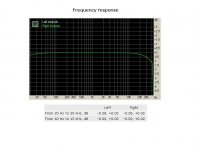Here I just tried the Xonar U5 at 24/192 line-in patched to headphone out on ARTA. You can get different/better results with speaker out all look pretty decent in general.
That looks good. I do have a FiiO X3 (24 bits/192kHz) I could use to output signal, and scan it with the Xonar. Or at least try if my (Win 7) PC can handle it
end the OT here.
Considering the title of this thread I don't think it's OT. It turns out the simplest way to tell is by using any program that will dump a tiny .wav to ascii text. Could you get Goldwave to work 24 bit? I found some of the exchanges between the Audacity developers and surprised users hilarious.
EDIT - (comment latest GW release)
.checked this beta and 5.67(Blizzard) and both dont do ASIO... :wow: ...wow, thats so lacking its almost a fashion statement lol... *no*
Last edited:
Whoa!... Hasn't this thread taken off or what?... For some reason, I stopped receiving notifications of new posts and had not idea.
From all the reading (here and elsewhere) and your feedback, my short list this far is:
From all the reading (here and elsewhere) and your feedback, my short list this far is:
- Focusrite Scarlett 2i2
- The QA400 (and hopefully the QA401 soon)
- Behringer UCA202
- Stenberger UR22MKII
I have used the emu 0202, tracker pre and 0404 with Win 7 in 192/24 full duplex. I have an RMAA report on the 0404 but have no idea how to share it as its an HTML file + directory.
So far my experience has been any win 7 driver works on win 10 just fine.
Keep in mind you are looking for a soundcard + software so the QA400 may be more than enough. It has some specific benefits like making sure the data is not dropped (a real problem in some audio card setups). Building an attenuator or interface for it is not that hard. I have posted two generations of designs that would work. The software is good enough and getting better.
Or you can use a usb sound card (I would strongly recommend a used EMU 0404 usb) and ARTA. Getting that sorted and running may be more hassle and work vs. a QA400 + you still have the I/O levels and interfaces to resolve.
So far my experience has been any win 7 driver works on win 10 just fine.
Keep in mind you are looking for a soundcard + software so the QA400 may be more than enough. It has some specific benefits like making sure the data is not dropped (a real problem in some audio card setups). Building an attenuator or interface for it is not that hard. I have posted two generations of designs that would work. The software is good enough and getting better.
Or you can use a usb sound card (I would strongly recommend a used EMU 0404 usb) and ARTA. Getting that sorted and running may be more hassle and work vs. a QA400 + you still have the I/O levels and interfaces to resolve.
How about this dirt cheap chinese box:
6 Channel 5 1 Audio External Optical Sound Card Adapter FOR PC Laptop Skype L4 | eBay
6 Channel 5 1 Audio External Optical Sound Card Adapter FOR PC Laptop Skype L4 | eBay
What makes a DAC different from a specialized sound card? You can buy pcm2704 USB boards really cheap.
Edit: stupid question, forgot that you need ADC as well. But still, are they capable of quality conversion and low latency?
Sent from my Nexus 4 using Tapatalk
Edit: stupid question, forgot that you need ADC as well. But still, are they capable of quality conversion and low latency?
Sent from my Nexus 4 using Tapatalk
Last edited:
What makes a DAC different from a specialized sound card? You can buy pcm2704 USB boards really cheap.
Edit: stupid question, forgot that you need ADC as well. But still, are they capable of quality conversion and low latency?
It is all about performance and features.
In terms of performance specialized audio interfaces that are used by professionals for recording often have better than +/- 0.1 dB frequency response and some have close to 120 dB dynamic range.
In terms of features, some have mic inputs with good preamps with phantom power that are valuable for the people doing speaker and acoustics measurements.
PCM2704 boards are way short in terms of performance and generally lack professional mic inputs with phantom power.
Now their performance may still be helpful if you are working on lower performance gear such as many vacuum tube products. It may be good enough for speaker and acoustical measurements.
I would consider leaving the mic preamp out of the USB sound card for a few reasons:
1. Cable interface has always been an issue of uncertain sound performance, I like the mic preamp to be closer to the mic or integrated into the mic boom.
2. To gain better signal level, having different gain levels for far and near level measurement seems more convenient, which is not normally available in existing sound cards.
3. Having unnecessary controls on the sound card just introduces more chances for accidental changes which may screw up your efforts.
1. Cable interface has always been an issue of uncertain sound performance, I like the mic preamp to be closer to the mic or integrated into the mic boom.
2. To gain better signal level, having different gain levels for far and near level measurement seems more convenient, which is not normally available in existing sound cards.
3. Having unnecessary controls on the sound card just introduces more chances for accidental changes which may screw up your efforts.
The pro and semipro interfaces like an EMU 0404 or 1616M or similar ditch all the "effects and a standard thing and those that make them available require a deliberate effort to get them. Phantom power means that the mike preamp is in the mike, different from power to an ECM type of mike that is sensitive to cable capacitance.
I have used the QuantAsylum QA400, EMU 0404, EMU 1616M, ESI Juli@ and an M-audio Transit and have results adequate for any professional application from all of them. If the hardware is adequate its more about how you use it and understanding how to get the most from it.
I have used the QuantAsylum QA400, EMU 0404, EMU 1616M, ESI Juli@ and an M-audio Transit and have results adequate for any professional application from all of them. If the hardware is adequate its more about how you use it and understanding how to get the most from it.
Having things like monitoring through headphones sometimes is a pain to work with. I have tried to help someone with it, but just could not get it to work right. TRANSIT works well, but it only goes up to 48KHz full duplex. The EMU cards looked interesting, I can't even remember why I did not get them when they came out. Juli@ is a PCI card...
Last edited:
I have an RMAA report on the 0404 but have no idea how to share it as its an HTML file + directory.I have used the emu 0202, tracker pre and 0404 with Win 7 in 192/24 full duplex. I have an RMAA report on the 0404 but have no idea how to share it as its an HTML file + directory.
So far my experience has been any win 7 driver works on win 10 just fine.
Keep in mind you are looking for a soundcard + software so the QA400 may be more than enough. It has some specific benefits like making sure the data is not dropped (a real problem in some audio card setups). Building an attenuator or interface for it is not that hard. I have posted two generations of designs that would work. The software is good enough and getting better.
Or you can use a usb sound card (I would strongly recommend a used EMU 0404 usb) and ARTA. Getting that sorted and running may be more hassle and work vs. a QA400 + you still have the I/O levels and interfaces to resolve.
Open the HTML on your p.c .Push print screen,open the windows <<paint >>
push contr+v .Now push file.save as.PNG or JPEG select a folder.
Re-open the HTML if you want scroll where you want push print screen ....thats it.
Sorry i don't know a better way.
Like this.http://www.diyaudio.com/forums/solid-state/235695-no-nfb-line-amp-gainwire-mk2-90.html
Attachments
Last edited:
I have an RMAA report on the 0404 but have no idea how to share it as its an HTML file + directory.
iXBT Labs - E-MU 0404 USB - Page 2: ASIO diagnostics, objective tests
Today I will crosspost the link as without a proper interface only the engineers will do things right  . Schew on it for a while... http://www.diyaudio.com/forums/tube...terface-ideas-suggestions-10.html#post4533036
. Schew on it for a while... http://www.diyaudio.com/forums/tube...terface-ideas-suggestions-10.html#post4533036
Regards
Regards
Arnie is there any free simple DAW like program that fully supports ASIO and will stream audio to a .wav on the disk at 24bits. Audacity, Goldwave, and Wavosaur do not. I tried Audacity with ASIO support and it still did not work, they all give zero padding and call the files 24bit.
Furthermore I think I'm being fooled by some other programs because the input is being resampled and filtered at 48K behind my back at floating point resolution and the upper byte is nothing but noise.
ARTA works fine on all the USB cards up to 24/192.
Arnie is there any free simple DAW like program that fully supports ASIO and will stream audio to a .wav on the disk at 24bits. Audacity, Goldwave, and Wavosaur do not. I tried Audacity with ASIO support and it still did not work, they all give zero padding and call the files 24bit.
Furthermore I think I'm being fooled by some other programs because the input is being resampled and filtered at 48K behind my back at floating point resolution and the upper byte is nothing but noise.
ARTA works fine on all the USB cards up to 24/192.
I know of none.
While ASIO is supposed to be the magic bullet for bit-perfect operation, your experiences, and the experiences of others show that this can't be counted on.
Depending on the release of Windows, the other driver interfaces may be good enough for instrumentation/testing. For example I did all of my testing on the old PCAVTech including the breathtaking LynxTWO results with Win XP 32 bit SP 2.
It is known for sure that Windows 8 and 10 have very messy (from an instrumentation viewpoint) resamplers when the sound mixer is used (please see Archimago's recent tests).
I seem to recall that Win 7.1 was appreciably better.
- Status
- This old topic is closed. If you want to reopen this topic, contact a moderator using the "Report Post" button.
- Home
- Design & Build
- Equipment & Tools
- USB sound card for audio spectrum analysis
